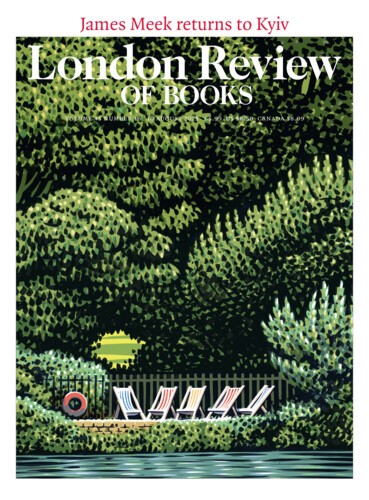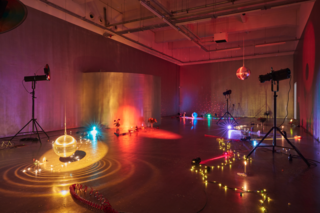Jade? Arsenic? Celadon? Eau de nil? I can’t remember ever worrying so much about the way I might describe the colours at an exhibition. A glass vase in the shape of a grasping hand, from which emerges the outline of a photographed bunch of dead blooms, and beside this a lacquer box panelled in a similar green: many such artefacts and finishes in Marc Camille Chaimowicz: Nuit américaine, at Wiels in Brussels (until 13 August), prompted this nomenclatural fret. With Chaimowicz, you want to get it right, because his version of dandyism has less to do with extravagance or show than nuance and degree. He stands, or lounges, with Verlaine: ‘Car nous voulons la Nuance encor, pas la Couleur, rien que la nuance!’ In front of a Chaimowicz sculpture, installation or fragment of interior design (these categories blur in his work) you find yourself troubled by the emotional gulfs between near identical greys.
He was born in Paris in 1947, to a Polish Jewish father and a French Catholic mother; the family moved to England in 1954, settling first in the new town of Stevenage. Chaimowicz studied at Camberwell, where he was taught by Frank Auerbach and R.B. Kitaj, and then at the Slade with William Coldstream. He rebelled against painting, but couldn’t follow his contemporaries into a fully conceptual assault on the material work itself. After a period in Paris in 1968, he returned to London and, it’s said, burned all his earlier work: he would focus now on contriving events, environments and atmospheres. At the same time, an unfashionable aestheticism asserted itself. Perhaps because of his mother – a seamstress who trained with a Paris couturier – he was unafraid of fabrics and patterns. He was drawn to the interiors of Bonnard and Vuillard, to a kind of shut-in dandyism of domestic space – des Esseintes relocated to 1970s Bethnal Green.
Much of Chaimowicz’s work is pale and delicately outlined, but his first major piece glitters away in the near dark. Celebration? Realife, which occupies the first room at Wiels, was first shown at the Gallery House in London in 1972. (Chaimowicz lived at the gallery during the run and would invite visitors to join him for coffee surrounded by the work.) In a darkened room – Wiels is a former brewery, and its galleries retain an industrial air – the pop-cultural moraine, scattered on the floor, suggests a party just past. Spotlights, candles and coloured filters pick out a ‘landscape’, as Chaimowicz puts it, of diverse and trashy leavings. There is a bust of Beethoven and a photograph of Lenin; magazines with the faces of Marilyn Monroe and John Lennon; small vases of dead flowers and strings of gleaming beads; a tiny Jesus and Virgin Mary, bathed in blue light; and the nonpareil marker of 1970s low-cost luxury, a Black Magic chocolate box.
Bedsit aftermath, campy museum collection, Duchamp-meets-discotheque constellation: Celebration? Realife is poised somewhere between a 1960s happening and its more mainstream incarnation a decade later. Music plays without pause: when I arrived, it was the Rolling Stones and Janis Joplin, but the mood was of a slightly later, more nostalgic period. The mood, that is, of early Bowie and Roxy Music, knowingly in thrall to images and objects from the 1950s, the 1930s, the 1890s. Stepping gingerly into the shadows, I half expected to meet a ghost of either gender in a feather boa, but there was just me and my phone, zooming in on dead party streamers, a Pierrot’s hat, cacti and old cameras. Chaimowicz revived Celebration? Realife in the late 1990s and has shown it regularly since, with small adjustments. Oddly out of time when it was first made, it now feels contemporary and immersive.
In 1979, Chaimowicz moved to a flat on Camberwell New Road in South London, and turned the sitting room into an installation of sorts, a semi-precious amalgam of modernist design, literary aestheticism and colours and forms that at times suggest the high street styles of the decade to come. (An almost forgotten stylistic continuum runs from 1920s Paris through the New Romantics to mid-1980s Topshop.) Dusty lemon, queen pink, pistachio, a great subtlety of greys. The Hayes Court Sitting Room (1979-2023) was soon ‘resolved’, as Chaimowicz put it; it remained more or less unaltered until he moved house in 2018. Deciding what to show at Wiels, Chaimowicz wrote to the curator, Zoë Gray: ‘I would like to send you my sitting room.’ The result, fanned out across four platforms, is a theatrical approximation of The Hayes Court Sitting Room, an exploded view of the dandy’s self-enclosing urge to make a world against the world.
As with des Esseintes, the point is to retreat into the interior, the better to find yourself elsewhere. The Hayes Court Sitting Room is partly the sitting room of Chaimowicz’s childhood in Paris. In some ways it is an ordinarily aspirant British postwar interior: the sombre Pye record player, the walnut drinks cabinet with folding leaves, a trio of fountain pens (including a transparent ‘demonstrator’ model). There are details that point to Chaimowicz’s own career, such as a private-view card for Partial Eclipse, his 1980 performance piece. But above all the room is a dream about European art and taste in the 20th century. One possible reason for Chaimowicz’s popularity among younger artists is that this displaced French artist reminds us of a faded English version of cultural Europhilia. There is Eileen Gray’s steel and glass side table, designed for her E1027 house at Roquebrune-Cap-Martin, and a photograph showing the face and hands of Jean Cocteau, modelled or cast in plaster. (For an exhibition at Norwich Gallery in 2003, Chaimowicz devised an apartment for Cocteau, featuring works by Warhol, Giacometti and Tom of Finland.) Throughout, there’s Chaimowicz’s customary lightness – in his muted colours, glassy reflections, his ‘poor man’s wallpaper’ whose motifs are painted on with special rollers.
Though Chaimowicz lived for nearly forty years with the domestic display conjured in this work, The Hayes Court Sitting Room seems distant, fantastical. Repeating a series he made in 1979, just before he moved to Hayes Road, photographs of a young man and woman stiffly inhabiting the sitting room – at Wiels these are shown behind the room displays, as if hidden under the walls – confirm his claim that the space was always a fiction. But what kind of fiction? One indebted to stories about decor as protective fantasy: des Esseintes’s underwater world; the anthropomorphic prison, with its caryatid spies and living candelabras, where the beast lives in Cocteau’s Beauty and the Beast; the bourgeois fantasies of Emma Bovary. The final room at Wiels is dedicated to photo collages, based on Flaubert’s novel, that Chaimowicz sent to Gray during the Covid lockdowns. Here are dream interiors derived from advertising, fashion photography and paintings: ‘A muted colour scheme of oyster pink, silver grey and sea green …’ Much of the imagery comes from the FT’s luscious weekend supplement, How to Spend It.
Send Letters To:
The Editor
London Review of Books,
28 Little Russell Street
London, WC1A 2HN
letters@lrb.co.uk
Please include name, address, and a telephone number.


